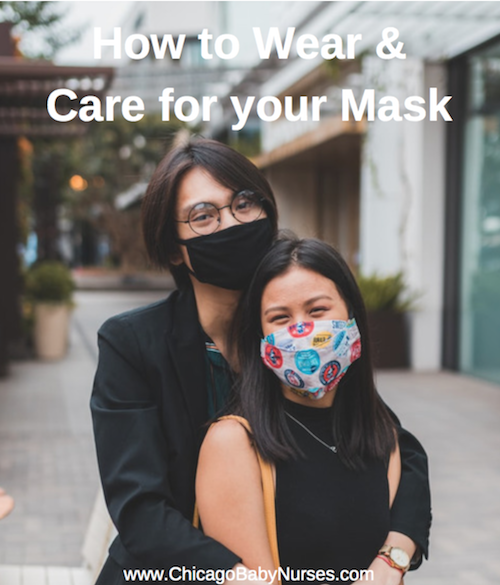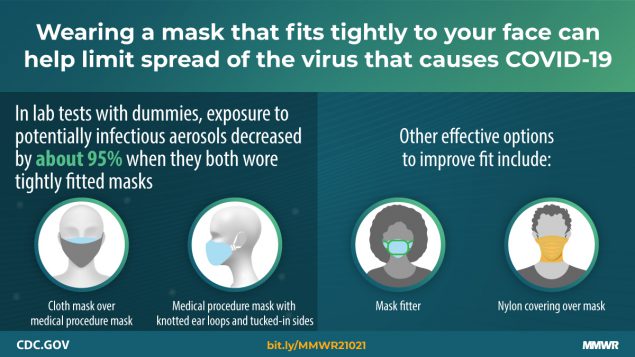How to Wear and Care for Your Mask
Masks are effective at preventing the spread of covid19 and other airborne illnesses when worn and stored properly. Know how to wear and care for your mask to stay safe:

Instead of simply saying Wear a mask! we’d like to say, Wear a mask…properly! Here are the most effective ways to wear a mask when out in public:
Surgical Masks– the light blue or green masks that have an appearance like paper.
- When you put it on, start by washing your hands for at least 20 seconds, hand sanitizer can be used as a secondary option if handwashing isn’t possible. When you pick up your mask, touch the sides/portion that goes around yours ears or head.
While they may not look like it, surgical masks, the ligth blu ones we’re used to seeing, have a top and bottom. The top is the straight part with wire and the wire should be pressed it to your nose, so it shapes to the bridge of your nose.
Masks worn below the nose are essentially useless and offer you and those around you no potential benefit.
- When you take a mask off, start by washing your hands, or sanitize. Remove by touching only the sides/portion that touched your ears or the back of your head.
- Never touch the inside of your mask! Once you do, that mask has been contaminated and is no longer safe to use.
- Surgical masks are meant for single use only. They are not made for multiple uses. If you must reuse it, use your clean hands to fold it so that the outside portion is exposed, and the inside is protected.
- If someone coughs or sneezes around you, or you are around someone who is sick, you MUST throw away your mask. This mask is now breeding bacteria between uses. If your mask gets wet, you must throw it away, it is no longer safe to use.
When should I wear a mask?
Wear a mask anytime you’re in an indoor public space and outdoors if you can’t stay 6ft away from others not in your household.
When can I *not* wear my mask?
- When in your home, provided everyone is covid-negative
- Outdoors as long as a 6ft. distance is maintained from persons not in your household
- In your car alone or with those you live with
- when eating a drinking
- engaged in strenuous activity where your mask impedes breathing
- when in labor and giving birth!
- kids 2 and under should not wear masks
How do I actually use my mask?
- Before you put on a mask, wash your hands for at least 20 seconds. Hand sanitizer can be used if handwashing isn’t possible. When you pick up your mask, touch the sides/portion that goes around yours ears or head…not the middle.
- If you’re wearing a surgical mask, note that they have a top and bottom and the top has a wire which should be pressed to form around the bridge of your nose. The same goes for commercial masks with wire on top, be sure the wire is shaped around your nose.
- Never touch the inside of your mask! Once you do, that mask has been contaminated and is no longer safe to use.
- Remove the mask by touching only the sides/portion that touched your ears or the back of your head.
- Wash and sanitize your hands again.
- Remember that your mask must cover your nose. If it’s worn below the nose it’s useless.
How do I take care of my mask?
Surgical masks:(the light blue/green ones)
- meant for single use only. They are not made for multiple uses. If you must reuse it, use your clean hands to fold it so that the outside portion is exposed, and the inside is protected.
- If someone coughs or sneezes around you, or you are around someone who is sick, you MUST throw away your mask. This mask is now breeding bacteria between uses.
- If your mask gets wet, you must throw it away, it is no longer safe to use.
Cloth masks:
- should be washed after EVERY use.
- Do not put a cloth mask back on if it becomes damp or wet.
- Do not wear it if you’ve been around a sick person prior to washing it.
- There are many different cloth masks but comfort and fit should be considered the most important things, since keeping the mask on and properly fitted helps keep you safe.
- Remember that the gaiter type of face covering may not be useful.
- Use a filter in your cloth mask if available. Many commercial masks are sold with filters but you can also use coffee filters or paper towels. These should be thrown away after each use.
Cloth Masks
Cloth masks should be washed after EVERY use. The above rules all still apply, and if you do not have a wire insert to shape around your nose, just be sure it is at least covering your nose. Do not put a cloth mask back on if it becomes damp or wet, or if you’ve been around a sick person the last time you wore it, prior to washing it.
What about Babies and Toddlers?
Masks are not recommended for babies and toddlers age 2 or younger.
The ideal situation to keep safe from covid19 in public is mask wearing combined with social distancing of 6 feet or more.

Lots of Americans are still not convinced that masks work even though evidence shows that masks, especially when coupled with social distancing do in fact slow the spread of coronavirus. (Here’s more evidence and another study).
As a response to those who say masks don’t work because “if air can get through the mask, so can virus particles,” Public Health RN and Infection Prevention Specialist Laura Hegarty-Moore said, “Of course some particles get through the mask but there’s a certain threshold called viral load that needs to be met in order for someone to get sick. Since a mask blocks a lot of the virus coming out, there’s likely not enough of a viral load escaping to make the person next to you sick.”
https://www.thelancet.com/journals/laninf/article/PIIS1473-3099(20)30237-1/fulltext
This blog was written by the Nurses of Let Mommy Sleep and Infection Control Specialist Laura Hegarty-Moore, RN PHS. If you have any questions about masks, let us know on Instagram or Facebook.
Categories
- Corporate Care & Partners
- COVID19 Archive
- En Espanol
- Expert Guides
- Hiring a Night Nanny
- Infant Safety
- Infant Sleep Hub
- Newborn Care
- Postpartum Health
- Twins & Multiples
- Work as a Night Doula
- zPost Archives
